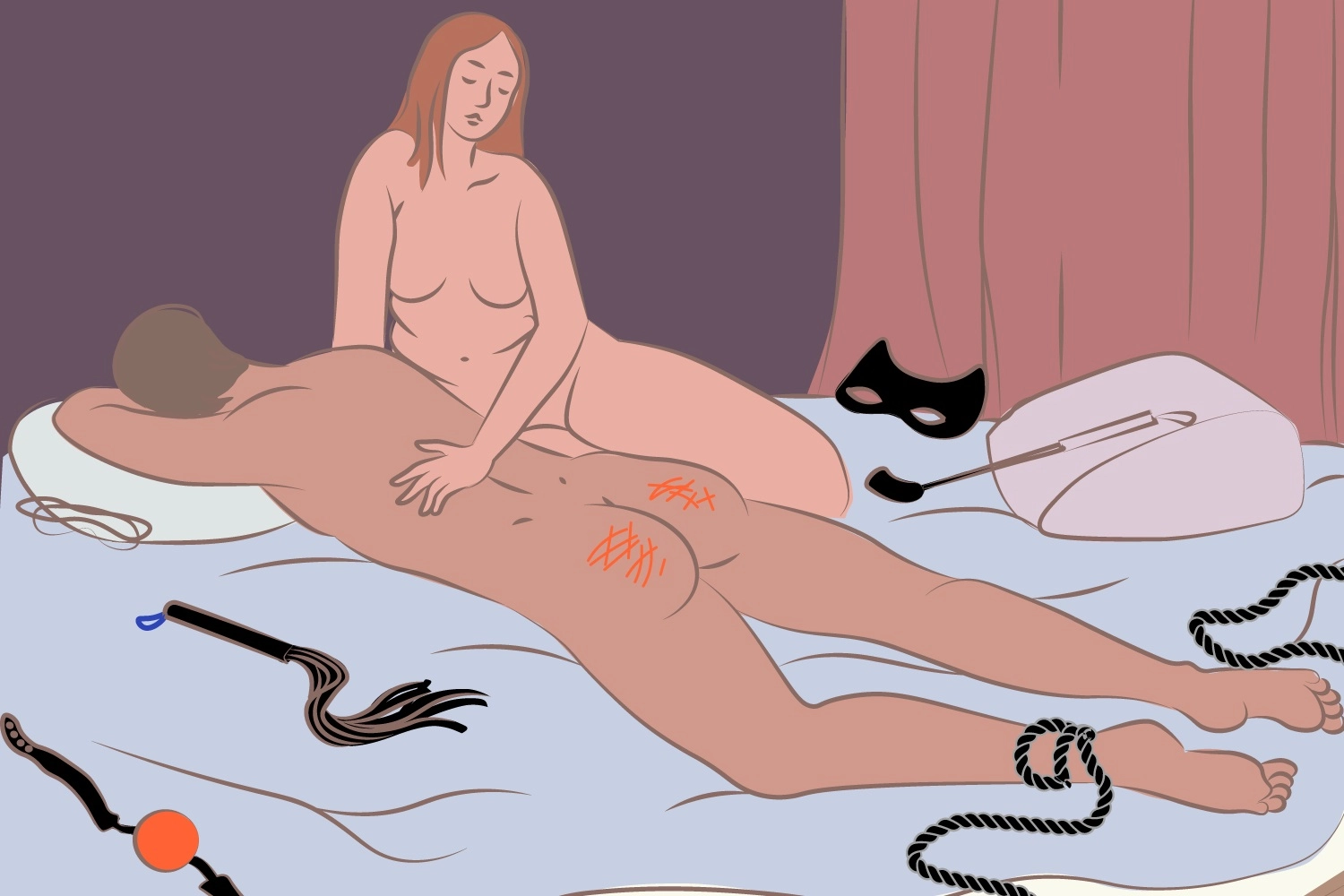Curious about BDSM but not sure where to begin? Then you’re in the right place!
Whether you've just stumbled upon the acronym or you've seen a few spicy videos online and want to try something similar with your partner, this guide will walk you through everything you need to know about BDSM for beginners.
You’ll learn what BDSM is, why so many people enjoy it, who it's for, how to get started, and which types of BDSM and positions are popular to explore.
From soft BDSM that involves feathers and blindfolds to BDSM spanking, rope play, and beyond - it’s all about trust, connection, and, most of all, pleasure. And if it turns out to be your thing? Well, Sinful is always here to help with the right toys and tools to make it unforgettable.
What Is BDSM?
Let’s start with the basics: What does BDSM stand for? BDSM is an acronym that covers a range of erotic practices. It stands for:
But what does BDSM mean in practice? It’s all about consensual play involving power dynamics, control, and physical sensations. The key word here is consensual - all BDSM play is based on clear communication and agreed-upon boundaries.
So, whether you’re tying up a partner, taking a spanking, or enjoying the emotional surrender of being called “Good Girl” or “Sir”, BDSM is as much psychological as it is physical.
Why Do We Enjoy BDSM?
You might be wondering why someone would enjoy being tied up or spanked. Well, it turns out the appeal of BDSM is both scientific and deeply emotional.
Engaging in BDSM can release endorphins and adrenaline - your body’s natural pleasure chemicals. Many people enjoy the intensity, the escape from control, or the deep trust built between partners. For others, it’s simply about the novelty and fun.
In fact, studies have shown that those who engage in BDSM can have strong communication skills and healthier relationships, mainly because BDSM requires negotiation, feedback, and emotional aftercare.
Who Can Engage in BDSM?
The short answer? Anyone. BDSM doesn’t require a particular gender, orientation, or experience level. Whether you’re exploring BDSM as a curious couple or flying solo with fantasies, it’s entirely up to you how deep you want to go.
If you’re a total beginner, starting slow with light BDSM or soft BDSM is a great idea. Think blindfolds, silk ties, or feather ticklers. These gentle introductions can help you discover what turns you on - and what doesn’t.

Popular Types of BDSM
Let’s break down some of the most popular types of BDSM to get your imagination going:
- Bondage - Using restraints (like cuffs, rope, or tape) to restrict movement.
- Discipline - Agreeing to rules or punishments (like a firm BDSM spanking) for playful misbehaviour.
- Dominance & Submission - Playing with control dynamics, where one person gives up power to another.
- Sadomasochism - Giving or receiving pain for pleasure. This could be anything from a spanking to wax play.
You don’t have to try everything. In fact, you’re encouraged to pick and choose. BDSM is not a fixed formula - it’s a buffet of kinks and pleasures to explore at your pace.
A Step-by-Step Guide to Practising BDSM
Ready to get started? Here’s how to ease into BDSM play, step-by-step:
- Talk about it: Before you even touch a toy or tie a knot, have an honest conversation with your partner. What are you both curious about? What’s a “yes,” “maybe,” or “hard no”?
- Agree on a safe word: This is a key part of consent. A safe word allows anyone to pause or stop the action. Popular safe words include “red” (stop), “yellow” (slow down), and “green” (all good).
- Choose a type of play: If you're just beginning, try light BDSM with something simple like a blindfold and teasing. Want something more physical? A bit of BDSM spanking over the knee or with a paddle could be just the thing.
- Set the mood: Music, lighting, and an inviting space all help create a vibe. Lay out toys, restraints, or lingerie in advance so you don’t have to break the mood looking for things.
- Play! Whether you're tying a wrist, giving a command, or counting out spanks, keep checking in with your partner. Watch for body language, and always respect limits.
- End with aftercare: This is crucial. Aftercare in BDSM involves checking in, cuddling, hydrating, and supporting your partner emotionally. The intensity of play can bring up a lot of feelings - aftercare helps you both land safely.
7 Tips and Tricks for a Safe and Sexy BDSM Start
Before you jump in, here are seven essential tips to help you explore BDSM safely, confidently, and with maximum pleasure.
- Start slow
: There’s no need to recreate a full dungeon scene on day one. One blindfold or a soft spank can be a big turn-on.
- Use safe words and signals
: They’re not optional. Make sure you both know how to use them and what they mean.
- Invest in beginner-friendly gear
: Beginner bondage kits and soft cuffs are a brilliant place to start.
- Communicate before, during, and after
: What felt good? What didn’t? This helps build trust and better experiences next time.
- Don’t play under the influence: It’s tempting, but alcohol or drugs dull your judgement and responses - not ideal in a setting that relies on clear consent.
- Learn basic safety: If you’re using restraints, always make sure you can remove them quickly. Keep safety scissors nearby if you’re playing with rope.
- Explore roles and scripts
: Roleplay can add a delicious psychological edge to your BDSM sessions. Whether it’s a strict headmaster or a naughty nurse - go with what excites you.
Recommended Products to Get You Started
Here are a few must-haves for anyone starting their BDSM journey:
You’ll find all of these (and so much more) on Sinful. Explore with confidence - we’ve got your back(side).
Frequently Asked Questions About BDSM
Got questions? You’re not alone. Here are the answers to some of the most common curiosities about BDSM.
What does BDSM stand for again?
It stands for Bondage and Discipline, Dominance and Submission, Sadism and Masochism.
Is BDSM dangerous?
Not when done consensually and safely. Communication, preparation, and proper tools help make BDSM fun and risk-aware.
Do I have to be dominant or submissive?
Not at all! You can try both and see what feels good. Many people switch roles depending on mood or partner.
What’s the difference between soft BDSM and hardcore play?
Soft BDSM (also called light BDSM) focuses on gentle teasing, sensory play, and playful power exchanges. Hardcore scenes often involve pain or intense domination - and usually come with more rules and precautions.
What are the best BDSM positions for beginners?
Positions like bending over a chair, lying on your stomach, or standing with hands restrained in front are simple, accessible, and perfect for exploring control without too much complexity. A great option for beginners is bed restraints, which let you secure wrists and ankles without complicated knots. They’re comfy, discreet, and perfect for hands-free teasing while your partner lies back and surrenders to the moment.
What is aftercare in BDSM?
Aftercare BDSM is the emotional and physical care partners give each other after a scene. It could be cuddles, snacks, or talking about the experience. It helps you both reconnect and feel safe. Read more about aftercare in this blog post.

Fancy a Bit of Kink?
BDSM isn’t just about whips and chains - it’s about connection, curiosity, and fun. As long as you communicate, play safely, and respect each other’s boundaries, there’s an entire world of sensation to enjoy.
Ready to explore? Start small, trust your instincts, and remember - Sinful is always here with the best BDSM ideas, gear, and guidance to keep your play exciting and safe.
Go on… have a little fun. You know you want to!


